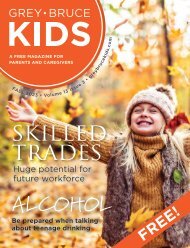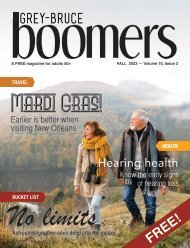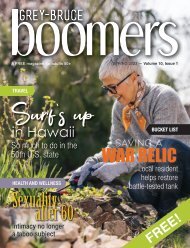You also want an ePaper? Increase the reach of your titles
YUMPU automatically turns print PDFs into web optimized ePapers that Google loves.
A FREE magazine for adults 50+<br />
<strong>Fall</strong> <strong>2020</strong> — Volume 5, Issue 3<br />
HEALTH & WELLNESS<br />
Importance of<br />
Geriatrics<br />
A Q+A on extended<br />
health care for seniors<br />
HISTORY<br />
COMMUNITY<br />
Racism<br />
in <strong>Huron</strong>/<strong>Perth</strong><br />
How you can grow to<br />
become anti-racist<br />
GODERICH’S<br />
LANCASTER<br />
BOMBER<br />
FREE!
PHASE 3 LOTS NOW<br />
AVAILABLE FOR BUILDING<br />
YOUR DREAM HOME!<br />
SPRING 2021 OCCUPANCY.<br />
P ETER J. H YD E<br />
H YD E CONSTRUCTION LIM ITED<br />
258 BURRITT ST, STRATFORD<br />
ONTARIO<br />
TEL: 519-271-1771<br />
INFO@ H YD ECONSTRUCTION.COM<br />
COMING SOON!<br />
CENTRALLY LOCATED<br />
10 BOUTIQUE APARTMENTS<br />
IN DOWNTOWN STRATFORD!<br />
AVAILABLE FALL <strong>2020</strong>.<br />
FOR MORE INFORMATION<br />
PLEASE EMAIL<br />
WILFRIDFLATS@GMAIL.COM<br />
D OWNTOWN GOD ERICH COND OS<br />
ALLOW SP ACIOUS, CAREFREE<br />
LIFESTYLE LIVING IN CANAD A'S<br />
P RETTIEST TOWN.<br />
VIEW THE MODEL UNIT TODAY-<br />
CALL DARRYL MITCHELL<br />
BROKER OF EXP REALTY<br />
CANADA INC. BROKERAGE<br />
GODERICH OFFICE 519-524-7193<br />
DIRECT 289-937-0367
<strong>Boomers</strong><br />
read<br />
our<br />
magazines.<br />
A free magazine for adults 50+<br />
Targeted Readership. High Quality.<br />
Local Content. Maximum Exposure.<br />
Call Amy at (519) 524- 0101<br />
or amy@<br />
huronperthboomers.com<br />
for advertising details<br />
FALL <strong>2020</strong> • 3
FROM THE PUBLISHER<br />
<strong>Fall</strong> is usually when we visit apple orchards, attend <strong>Fall</strong> Fairs, cover our outdoor<br />
plants in preparation for the first frost, get those last rounds of golf in, and even<br />
start planning where we’ll spend our winters, whether just for a couple of weeks or<br />
for months at a time.<br />
This year, obviously, looks a little different due to the upheaval to the norm caused<br />
by the COVID-19 pandemic. Now we’re preoccupied with buying facemasks,<br />
restocking hand sanitizer, talking to travel agents about cruise ship refunds, and<br />
watching the news south of the border with hopes our winter travel plans aren’t a<br />
long shot at best. Some of our readers may even be looking for a place to live when<br />
the weather turns cold, as more retirees don’t keep a winter home in <strong>Huron</strong>/<strong>Perth</strong><br />
anymore, spending the coldest months in a condo or trailer down south, while<br />
living the cottage life locally during our beautiful summers.<br />
CONTENTS<br />
Travel • 6<br />
History • 12<br />
Community • 16<br />
Health & Wellness • 22<br />
Senior Spotlight • 26<br />
Recipe • 28<br />
This isn’t exactly news, but COVID has changed almost every aspect of our<br />
lives, including here at <strong>Huron</strong>-<strong>Perth</strong> <strong>Boomers</strong>. We still have the same great local<br />
content, resources and advertisers, but you won’t be able to pick up a copy at the<br />
dentist’s office, grocery store or pharmacy — instead you can read us anywhere<br />
and everywhere as we are again exclusively digital. Our user-friendly platform<br />
allows direct links to all websites, which makes it easy for you to learn more about<br />
what interests you and to visit our amazing local advertisers (who still need your<br />
support!).<br />
While we do hope to return to print soon, in the meantime please like our Facebook<br />
page and interact with and share our posts, subscribe to our online newsletter, and<br />
support the advertisers who were able to support us in these difficult times.<br />
We wish you and your family continued good health<br />
and hope you can enjoy what our area has at this most<br />
beautiful time of year — socially distanced, of course!<br />
Amy Irwin, Publisher<br />
<strong>Huron</strong>-<strong>Perth</strong> <strong>Boomers</strong><br />
FALL <strong>2020</strong><br />
Publisher<br />
Amy Irwin<br />
amy@huronperthboomers.com<br />
Magazine Design<br />
Becky Grebenjak<br />
<strong>Huron</strong>-<strong>Perth</strong> <strong>Boomers</strong> welcomes<br />
your feedback.<br />
EMAIL<br />
amy@huronperthboomers.com<br />
PHONE 519-524-0101<br />
MAIL<br />
P.O. Box 287, Ripley, ON N0G 2R0<br />
<strong>Huron</strong>-<strong>Perth</strong> <strong>Boomers</strong> is distributed for free in <strong>Huron</strong> and <strong>Perth</strong><br />
counties, and is published each March, June, September, and<br />
December. Distribution of this publication does not constitute<br />
endorsement of information, products or services by <strong>Huron</strong>-<strong>Perth</strong><br />
<strong>Boomers</strong>, its writers or advertisers. Viewpoints of contributors and<br />
advertisers are not necessarily those of the Publisher. <strong>Huron</strong>-<strong>Perth</strong><br />
<strong>Boomers</strong> reserves the right to edit, reject or comment on all material<br />
and advertising contributed. No portion of <strong>Huron</strong>-<strong>Perth</strong> <strong>Boomers</strong> may<br />
be reproduced without the written permission of the Publisher.
DISCOVER THE APARTMENTS AT HARBOUR HILL<br />
JUST RELEASED<br />
ONE AND TWO BEDROOM APARTMENTS<br />
104 Suncoast Drive East, Goderich • 519-440-0110
TRAVEL<br />
Coast down<br />
Costa Rica<br />
to<br />
FUN IN THE SUN ON THE ‘RICH COAST’<br />
STORY AND PHOTOS BY JILL ELLIS-WORTHINGTON<br />
6 • HURONPERTHBOOMERS.COM
y Jill Ellis-Worthington<br />
TRAVEL<br />
For those of us who live in Canada but long for Julylike<br />
weather year-round, Mother Nature has an<br />
answer – Costa Rica.<br />
It’s a wild, beautiful country where ocean meets beach<br />
and jungles climb the mountains. Located in Central<br />
America, between Nicaragua and Panama, the Republic<br />
of Costa Rica was colonized by the Spanish in the 1600s,<br />
after Christopher Columbus landed there in 1502.<br />
A great region to explore on a first visit is the Playa Bejuco<br />
area, near Jaco and Quepos, on the central west coast.<br />
These small towns give a taste of local fare and culture,<br />
and Playa Bejuco is positioned among many recreational<br />
activities to enjoy between swims. Visitors value pools and<br />
beaches for relief from temperatures that range between<br />
30 and 35 C (with high humidity) in the winter months.<br />
Those wishing to stay anywhere along the coast usually fly<br />
into San Jose, which is the capital and largest city, hosting<br />
the more northern of the two international airports in the<br />
country. A two-hour ride through the mountains to the<br />
coast provides a breathtaking introduction to the scenery.<br />
You’ll experience the rugged mountains and the more<br />
rugged roads that transverse them. National Highway 34<br />
is a paved, well-kept, two- and sometimes four-lane road<br />
that takes you from the airport to Playa Bejuco, but many<br />
are gravel and very rough because of the heavy summer<br />
rains. Be warned if you are renting a car, local drivers<br />
often pass on hills and curves without warning, making<br />
driving a nerve-wracking prospect at times.<br />
Since it’s located near the equator, Costa Rica experiences<br />
almost the same amount of dark and light each day. The<br />
sun usually rises around 6 a.m. and sets around 6 p.m.<br />
This causes many visitors to readjust their internal clocks,<br />
which is fortunate because the coolest part of the day is<br />
right around dawn – a wonderful time to take a walk or<br />
take care of any strenuous activities. So, going to bed<br />
around 9 p.m. and rising at 5 a.m. is something that many<br />
visitors (and expats living there) commonly experience.<br />
Left: Costa Rica is a mountainous country.<br />
Above: Walking through Carara National<br />
Park reveals a plethora of interesting flora<br />
and fauna.<br />
Bottom: Seeing red macaws flying is always<br />
a thrill.<br />
The day is marked by the sunrise/sunset routine.<br />
Grabbing a chair or blanket and heading to the beach<br />
to enjoy the sunset, before going back to the lodgings for<br />
dinner, is a daily treat. The sun setting over the Pacific is<br />
a truly spectacular site.<br />
FALL <strong>2020</strong> • 7
TRAVEL<br />
by Jill Ellis-Worthington<br />
Above: The El Avion Restaurant was featured in<br />
the Tom Cruise movie ‘American Made.’<br />
Top right: Iguana Chocolate Tour guide<br />
demonstrates taking chocolate from beans to<br />
bonbons while expat Fred Vojt looks on.<br />
Bottom right: From Winnipeg, vacationer Alisha<br />
MacMillan takes a turn crushing cocoa beans<br />
while expat Jane Perry David looks on.<br />
8 • HURONPERTHBOOMERS.COM
y Jill Ellis-Worthington<br />
TRAVEL<br />
Between sun-up and sun-down, there is plenty to do and<br />
see in the area. In Playa Bejuco, you are equidistance from<br />
two great hiking opportunities. An hour’s drive south<br />
is Manual Antonio National Park and an hour north<br />
is Carara National Park. At the latter, you have a good<br />
chance of seeing scarlet macaws, colourful butterflies and<br />
moths, various types of lizards, tree-climbing ant eaters,<br />
howler monkeys and agoutis (a long-legged rodent the<br />
size of a large rabbit). The massive Guanacaste trees<br />
are stars of the show, and there are myriad of flowering<br />
plants providing a visual feast.<br />
If you venture to the former, a drive through the village<br />
of Manuel Antonio is very enjoyable along the winding,<br />
mountain roads. Two must-stops in this area are Biesanz<br />
Beach and El Avion restaurant. The beach is a steep<br />
climb down a hillside on rough terrain, so not ideal for<br />
those with bad knees, but it’s very much worth the effort.<br />
It has gently rolling waves – rather than the crashing surf<br />
at Playa Bejuco beach, which is ideal for boogie boarding<br />
On estuary boat tours,<br />
guides call monkeys<br />
from the jungles.<br />
FALL <strong>2020</strong> • 9
TRAVEL<br />
by Jill Ellis-Worthington<br />
or surfing but makes swimming difficult – a beautiful vista<br />
and rental beach chairs and sunshades. Bring a cooler<br />
with your drinks and food or buy some from the bar<br />
there, but be warned it is expensive.<br />
If you’ve seen the movie American Made with Tom<br />
Cruise, you might recognize the airplane that forms part<br />
of the restaurant El Avion. Perched on the edge of the<br />
mountain high above the ocean, this restaurant offers<br />
excellent food and drink, complemented by fantastic views<br />
from every table. Served at this and most restaurants,<br />
carpaccio de atun roja is a raw tuna dish made with diced<br />
mango and avocado – so fresh and delicious!<br />
Head into Quepos for the weekly Friday and Saturday<br />
mercado (market) to pick up fresh fruit, fish and meat,<br />
as well as tourist souvenirs. Jaco also has a street full<br />
of tourist shops. Open air restaurants with luxurious<br />
gardens line the side streets. Check out Senor Harry’s for<br />
a cool drink on the shaded patio when you’re doing more<br />
dropping than shopping.<br />
Top: Writer Jill Ellis-Worthington (left) and<br />
expat Colleen O’Brien are ready to zip line.<br />
Below: Beautiful beaches give way to<br />
stunning mountains in Costa Rica.<br />
Adventurous souls will also find their calling in Costa<br />
Rica. From travelling challenging mountain roads up to<br />
the organic family-run fruit farm that houses La Iguana<br />
Chocolate Tours, to traversing the swinging bridges<br />
at Rainmaker Conservation Project, to taking on 14<br />
different ziplines at Chiclets Zipline (Hermosa Tours),<br />
there’s something for all adrenaline junkies.<br />
The chocolate tour includes a narrative on all aspects of<br />
growing and harvesting cocoa and the guide shows you<br />
how to make truffles (to gobble up) from cocoa beans. It is<br />
hands-on fun that also includes a lunch of authentic area<br />
cuisine if you choose that option for a small additional<br />
fee. You may also see scarlet macaws or toucans that<br />
perch in the fruit trees around the property.<br />
For both heart-stopping action and heartrending beauty,<br />
ziplining down a mountain is a real experience. The<br />
staff at Chiclets is excellent at making sure everyone is<br />
safe and know how to take on each of the 14 ziplines.<br />
When landing on the tree-top platforms, you overlook the<br />
beautiful white sand beaches and emerald jungles that<br />
rim the sapphire blue ocean.<br />
Animal lovers will appreciate getting up close and personal
y Jill Ellis-Worthington<br />
TRAVEL<br />
Villa Caletas offers diners<br />
amazing views.<br />
with the local monkey population on a boat-in monkey<br />
tour. From the edge of the estuary, you venture forth on<br />
a canopied flat-bottomed boat at low tide. Guides call<br />
the Capuchin monkeys from the forest. These friendly<br />
creatures have soft hands and gently take fruit from you<br />
and climb over you if you are comfortable with it.<br />
Finding great food isn’t a problem in this area of Costa<br />
Rica. At Esterillos town centre, La Rioja Tapas y Vinos<br />
offers amazing oven-fresh pizza. Thursday night is pasta<br />
night, featuring a pasta of the day and glass of wine for<br />
$9 US. Jardines Café is in the same plaza and is a great<br />
place to enjoy a hearty breakfast.<br />
Many expats also offer accommodation in this area, and<br />
these types of arrangements are an affordable option and<br />
usually include use the community pool in a complex<br />
or the owner’s private pool, laundry facilities, kitchen<br />
privileges and/or breakfast included.<br />
Boutique hotels on the beach are often reasonably priced<br />
and have restaurants. Larger properties have resort<br />
amenities, as well as excellent restaurants. Many feature<br />
lush properties with stunning infinity pools, excellent<br />
restaurants, spas and some of the most magnificent views<br />
on the coast because you’re looking at both the ocean and<br />
the Nicoya Peninsula.<br />
So when you’re seeking summer during the Canadian<br />
winter, experience Pura Vida (pure life) in Costa Rica.<br />
Jill Ellis-Worthington is a writer, editor and communications<br />
consultant. Visit her online at writeoncommunicationservices.com.<br />
FALL <strong>2020</strong> • 11
HISTORY<br />
CANADA’S<br />
LANCASTER<br />
BOMBER<br />
SECOND WORLD WAR PLANE ONCE HELD A<br />
PROMINENT PLACE IN GODERICH. BY JOHN MELADY<br />
12 • HURONPERTHBOOMERS.COM
y John Melady<br />
HISTORY<br />
During the Second World War, on the night of<br />
June 12, 1944, over Cambrai, France, a Lancaster<br />
bomber was shot down by a German fighter.<br />
As it happened, the mid upper-gunner aboard the Lanc<br />
was Winnipeg-born Andrew Mynarski. When he heard<br />
the bail-out order, he went to the aid of the rear gunner<br />
who was trapped in his position. However, when Mynarski<br />
could not free the man, he was forced to bail because by<br />
this time, much of the aircraft and his own flight suit were<br />
both on fire. Before leaving the plane however, he stood<br />
at attention and saluted the apparently doomed man he<br />
could not save. Subsequently, Mynarski was found by<br />
French citizens but soon died of his burns.<br />
Miraculously, the man he tried to save survived, and<br />
Mynarski was awarded a posthumous Victoria Cross<br />
for his bravery that night. Many years later, he and his<br />
heroism would be remembered again, but in a different<br />
way. This time, the remembrance had a close connection<br />
to <strong>Huron</strong> County.<br />
For several years, there was a Canadian-built Lancaster<br />
bomber on a cement pylon in front of the Legion Hall in<br />
Goderich. The plane was truly a reminder of this nation’s<br />
contribution to the winning of a terrible war. There<br />
were 7,377 Lancasters built in Britain and Canada,<br />
and, while the one in Goderich was not one of them, it<br />
reminded those who saw it of the thousands of young<br />
Canadians who perished in the air. The Goderich plane<br />
was formally dedicated to the memory of Mynarski, but<br />
then, after much discussion, was removed from its pylon<br />
in <strong>Huron</strong> and taken to the Warplane Heritage Museum<br />
in Hamilton in 1979.<br />
The trip from Goderich was quite unusual, and the<br />
transport of the Lancaster was used by the Air Force as<br />
a training exercise. The plane on the pylon was carefully<br />
secured for the journey, and then was slung under a<br />
Chinook helicopter, lifted, and carried to the Hamilton<br />
site.<br />
Then, nine years later, after being painstakingly restored,<br />
the Mynarski Lancaster was made to fly again! The<br />
occasion of its flight was indeed a day of celebration as<br />
an estimated 20,000 people were there to watch. They<br />
came from across Canada and far beyond.<br />
Author John Melady<br />
before his flight in<br />
the Lancaster.<br />
Today, the Lancaster, as restored, has pride of place<br />
at the Hamilton museum. It participates in air shows<br />
across this country, but in 2014 made a truly remarkable<br />
journey. The plane was flown to Britain in order to linkup<br />
with the only other operational Lancaster. During that<br />
summer, the two aircraft were seen together in the skies<br />
over Britain and their very presence evoked memories<br />
for many of the war years when these great planes<br />
participated in bombing Germany and helping to win the<br />
war against Hitler. Canada’s Mynarski bomber was away<br />
for seven weeks that year. On the way home it made stops<br />
in Iceland, Greenland, Labrador and Quebec, and was<br />
admired in each.<br />
FALL <strong>2020</strong> • 13
HISTORY<br />
by John Melady<br />
Many people who saw it on that pedestal at Goderich still<br />
marvel at the size of the plane; it was almost 70 feet long,<br />
and had a wingspan of over 100 feet, and, because of that<br />
size, it was capable of carrying the largest bombs. The<br />
aircraft also had an amazing range for the time – about<br />
2,500 miles, which enabled it to carry great ordinance<br />
loads deep into enemy territory before attempting to<br />
return to the UK.<br />
Canadians from all over flew in the Lanc during the war,<br />
including Jake Cornish, of Brucefield, who was attached<br />
to the Australian Air Force and was the only survivor<br />
when the plane he was in was shot down over Holland.<br />
He was 22 at the time.<br />
The Lancaster was probably the most well-known Allied<br />
bomber of the Second World War. Its four Merlin engines<br />
were loved as much for their unique sound as for their<br />
efficiency. I am lucky enough to have heard them, and<br />
some time ago was thrilled to fly in the Lancaster during<br />
an appearance at an Air Force Day at CFB Trenton. I<br />
recall climbing into the aircraft, and knowing at the time<br />
that this was the same plane that intrigued so many on<br />
that pylon at Goderich. I was in the cockpit that day, and<br />
even had the chance to look out the mid upper-gunner’s<br />
position on the roof of the plane. However, because of<br />
cloud cover I was unable to see anything from there. I did<br />
remember Mynarski and thought of the valiant sacrifice<br />
he made that night, so many decades ago.<br />
During the Second World War, the Lancaster was the<br />
plane that was instrumental in the destruction of the Ruhr<br />
dams in May 1943. This was the well-known ‘Dambuster’<br />
operation. It also participated in the sinking of the great<br />
German battleship Tirpitz in November 1944. Both feats<br />
were as extraordinary as they were disheartening for the<br />
Axis enemy.<br />
14 • HURONPERTHBOOMERS.COM
y John Melady<br />
HISTORY<br />
In all, there were 430 Lancasters built in Canada, and,<br />
at its peak, almost one plane a day rolled off the Victory<br />
Aircraft assembly line in Toronto. At one time, No. 6 group<br />
of Bomber command flew 13 squadrons of Lancasters<br />
from various places in England. Sadly, many of them<br />
never came home from bombing raids to Germany.<br />
Anyone who flew the Lanc in wartime or since, marvels at<br />
its ease of handling. This was particularly important in the<br />
night skies over Europe when no pilot knew of the precise<br />
danger ahead; when the bomb load being carried was<br />
great; when everyone on board had to be on the lookout<br />
for enemy aircraft; or whether or not a crippled Lancaster<br />
would ever make the trip back to friendly skies again.<br />
The Mynarski Lanc, as it has been called, was built<br />
in July 1945. It was then used as a patrol aircraft out<br />
of Greenwood, Nova Scotia, and then from Torbay,<br />
Newfoundland, until late-1963, when it was retired<br />
from the Air Force. And even while the plane no longer<br />
intrigues observers at the Legion in Goderich, it has since<br />
become known far and wide as a flying museum piece<br />
that hopefully lasts a very long time.<br />
Today, those who see it or fly in it will never forget it. And<br />
it is not only the aircraft; it is also the memory of Andrew<br />
Mynarski that is recalled.<br />
Both deserve to be remembered for generations – whether<br />
in Goderich or elsewhere.<br />
John Melady is the author of 13 books and many newspaper and<br />
magazine articles. He also reviewed books for the Globe & Mail<br />
for several years. His books are available through Chapters/Indigo,<br />
Amazon and other bookstores.<br />
FALL <strong>2020</strong> • 15
COMMUNITY<br />
Rural<br />
racism<br />
HOW THE MURDER OF GEORGE FLOYD HAS SPARKED<br />
A LONG-OVERDUE DISCUSSION. BY BEN FORREST<br />
16 • HURONPERTHBOOMERS.COM
y Ben Forrest<br />
COMMUNITY<br />
On a sunny Saturday in early June, about two weeks<br />
after the murder of George Floyd at the hands of<br />
Minnesota police, several dozen people gathered at Milt<br />
Dunnell Field in St. Marys and marched downtown in<br />
solidarity with the Black Lives Matter movement.<br />
They carried signs that said, “Enough is enough,”<br />
“Racism exists here,” and “Be Anti-Racist,” but were<br />
mostly silent as passing motorists honked in support.<br />
When they reached the historic town hall, a late-19th<br />
Century building made with limestone and red sandstone,<br />
the group raised their fists and knelt for several minutes to<br />
protest police brutality and discrimination against Black,<br />
Indigenous and People of Colour (BIPOC). Then they<br />
rose to their feet, marched quietly back to the park, and<br />
went about their business in a world that seemed to be<br />
rapidly changing around them.<br />
Similar protests took place across southwestern Ontario,<br />
We power the<br />
future.Our long-term<br />
private investment in refurbishing<br />
our nuclear fleet will ensure Ontarians receive<br />
clean, reliable, low-cost electricity and life-saving<br />
isotopes for generations.<br />
brucepower.com<br />
FALL <strong>2020</strong> • 17
COMMUNITY<br />
and both police and cultural institutions were forced to<br />
acknowledge the systemic racism that led to Floyd’s death,<br />
and the deaths of Ahmaud Arbery, Breonna Taylor, Regis<br />
Korchinski-Paquet and countless others.<br />
The Stratford Police Service, which serves St. Marys,<br />
<strong>Perth</strong> South and the City of Stratford itself, posted a<br />
statement to Twitter acknowledging the hurt, anger and<br />
frustration felt in the community after Floyd’s death.<br />
“As police officers, we have an obligation to keep our<br />
community safe, and to do so with fairness, justice,<br />
respect and equality,” it said. “We know that we are not<br />
perfect. We know that we need to continuously work with<br />
our community to make meaningful strides toward longlasting<br />
change.”<br />
At the world-renowned Stratford Festival, Black actors<br />
launched the Twitter hashtag #inthedressingroom to<br />
share stories about racist behaviour they’ve experienced,<br />
and the festival temporarily handed over its social media<br />
feeds to BIPOC artists.<br />
“As a company we have upheld white supremacy in<br />
the past,” said Antoni Cimolino, artistic director of the<br />
festival, and Anita Gaffney, executive director, in a joint<br />
statement. “It must be dismantled. We are committed<br />
to using this time to evolve our understanding of equity,<br />
inclusion, and anti-racism to prepare to celebrate and<br />
give platform to a more diverse array of voices when we<br />
return.”<br />
In a part of the world geographically distant from<br />
louder, angrier protests south of the border and in larger<br />
Canadian centres, there was at least some recognition that<br />
racist behaviour is all too common here, rooted in bigotry<br />
that stretches back centuries and has never entirely gone<br />
away.<br />
“We are heartbroken and angry at the violent anti-Black<br />
and anti-Indigenous racism we see across Turtle Island,”<br />
said Cimolino and Gaffney. “We stand in solidarity with<br />
those demonstrating for justice… Black Lives Matter.<br />
Today and everyday (sic).”<br />
What we mean when we talk about racism<br />
In her book White Fragility: Why it’s so hard for white people<br />
to talk about racism, the sociologist Robin DiAngelo, who<br />
is white, challenges the traditional definition of racism.<br />
While most people think of racism as a synonym for<br />
prejudice and discrimination, DiAngelo defines it as a<br />
18 • HURONPERTHBOOMERS.COM
y Ben Forrest<br />
system that functions independently of the attitudes and<br />
self-image of people within that system.<br />
Prejudice is a prejudgment of another person based on<br />
the social groups to which the person belongs, she writes.<br />
This includes the thoughts, feelings, stereotypes, attitudes<br />
and generalizations that are projected onto everyone<br />
from that group.<br />
“All humans have prejudice; we can’t avoid it,” DiAngelo<br />
says. “People who claim not to be prejudiced are<br />
demonstrating a profound lack of self-awareness.”<br />
Discrimination, on the other hand, is action based on<br />
prejudice. This can include ignoring someone, excluding<br />
them, making threats, ridiculing them, and acts of<br />
violence. Again, she argues, everyone discriminates.<br />
But when a racial group’s prejudice is backed by legal<br />
authority and institutional control, it becomes racism.<br />
The same is true of sexism and other forms of oppression.<br />
DiAngelo uses the example of the women’s suffrage<br />
movement to illustrate this idea.<br />
“While women could be prejudiced and discriminate<br />
against men in individual interactions, women as a group<br />
could not deny men their civil rights. But men as a group<br />
could and did deny women their civil rights. Men could<br />
do so because they controlled all the institutions.”<br />
Historian Ibram X. Kendi, director of the Antiracist<br />
Research and Policy Center at American University,<br />
argues the terms “institutional racism,” “structural<br />
racism” and “systemic racism” are redundant.<br />
“Racism itself is institutional, structural, and systemic,”<br />
he writes.<br />
Racism in Canada<br />
In Canada we are as fond of our myths as people in any<br />
other country. The phrase, “I’m not racist. I’m Canadian!”<br />
is meant to be funny, and to paint our country as a place<br />
of inclusive, overly-polite, well-meaning and harmless<br />
folk who are just killing time between now and their next<br />
hockey game or pint of beer.<br />
But scholars are quick to point out that Canada, like<br />
the U.S., is a product of stolen and colonized land.<br />
Both countries have been accused of genocide against<br />
Indigenous Peoples. Although Canada was a destination<br />
for slaves escaping the U.S. in the 19th Century,<br />
thousands of Indigenous and Black people were bought,<br />
sold and inherited as if they were property in Canada.<br />
Slavery existed in New France in the early-1600s and<br />
continued for about 200 years, only to morph into various<br />
government policies, as outlined in stunning detail in<br />
Robyn Maynard’s book Policing Black Lives: State Violence in<br />
Canada from Slavery to Present.<br />
“In Canada we talk a lot about the Underground<br />
Railroad, Black people escaping slavery and coming to<br />
Canada,” said Rinaldo Walcott, chair of the Department<br />
of Sociology and Equity Studies at the University of<br />
Toronto, in an interview with the CBC. “But we don’t<br />
also talk about how, after the end of the Civil War in the<br />
U.S., many of those same Black people went back to the<br />
U.S. And why did they go back? Because on the other side<br />
of the border, things were just as bad.”<br />
In early Canada, a major purpose of the Royal Canadian<br />
Mounted Police was to suppress Indigenous dissent, and for<br />
decades the Canadian government uprooted Indigenous<br />
children from their homes and placed them in Residential<br />
FALL <strong>2020</strong> • 19
COMMUNITY<br />
by Ben Forrest<br />
As Canadians, we like<br />
to claim racism only<br />
exists to the south.<br />
Our history of slavery<br />
and colonialism<br />
proves otherwise.<br />
Schools where physical and sexual abuse was common.<br />
The legacy of Residential Schools has been passed down<br />
for several generations and is still being felt today.<br />
Canada’s legal system also disproportionately<br />
incarcerates people who are not white. Black and<br />
Indigenous people make up nearly 40 per cent of<br />
Canada’s federal prison population, despite the fact they<br />
make up less than 10 per cent of the general population,<br />
a CBC investigation found.<br />
“We’re literally paying for police officers to brutalize and<br />
kill us at disproportionate rates,” said Pam Palmater, a<br />
Mi’kmaq lawyer and Ryerson University professor, in a<br />
CBC interview.<br />
The use of racial slurs and stereotypes, off-colour jokes and<br />
mocking impressions are prejudicial and discriminatory,<br />
and are rooted in white supremacist beliefs. But some<br />
scholars argue that being passive in a racist system is a<br />
form of complicity. As a result, it is not enough to declare<br />
ourselves “not racist.” We must be anti-racist.<br />
“You don’t have to be a protester,” said Palmater. “There’s<br />
a thousand different ways that people can contribute. But<br />
silence is also violence.”<br />
Community response<br />
Although the recent response to racism in <strong>Huron</strong> and<br />
<strong>Perth</strong> is simply the start of a long-overdue conversation<br />
about race, discrimination and prejudice, there have been<br />
steps in the right direction.<br />
The Stratford Festival has announced several measures,<br />
including sensitivity training for staff, increased funding<br />
for BIPOC artists, and a commitment to amplify<br />
marginalized artists through the plays it commissions.<br />
Both counties have local immigration partnerships<br />
committed to building welcoming and more inclusive<br />
communities for newcomers from other countries.<br />
The <strong>Huron</strong> Multicultural Festival in Goderich draws<br />
about 2,500 visitors each year, with performances and<br />
food from people with cultural roots around the world.<br />
The <strong>Perth</strong>-<strong>Huron</strong> United Way’s Social Research &<br />
20 • HURONPERTHBOOMERS.COM
y Ben Forrest<br />
COMMUNITY<br />
Planning Council completed a diversity study in 2017<br />
aimed at attracting newcomers to both communities,<br />
and, while several cultural events have shifted online due<br />
to COVID-19 and pernicious attitudes and behaviour<br />
remain a concern, there appears to be a genuine desire<br />
for change.<br />
Anti-racism is active, conscious and ongoing. It requires<br />
humility, discomfort and hard work by those of us who<br />
are seen as white, and it requires an awareness of our<br />
blind spots. It also requires recognizing white privilege<br />
and using it to change institutions that disadvantage<br />
people who are not seen as white.<br />
“We must never consider ourselves finished with our<br />
learning,” writes DiAngelo. “It is a messy, life-long<br />
process, but one that is necessary to align my professed<br />
values with my real actions. It is also deeply compelling<br />
and transformative.”<br />
Strategies for combating racism<br />
Educate yourself. There are dozens of books, movies<br />
and websites that can teach us about histories, ideas and<br />
cultures unlike our own. By learning, we gain empathy<br />
and begin to see a path forward.<br />
Do the work. You are responsible for your own antiracist<br />
education. It’s not the responsibility of your<br />
BIPOC friends, family or community members to bring<br />
you up to speed.<br />
Confront racist ideas when you encounter them.<br />
Being anti-racist means holding your friends, family and<br />
co-workers accountable. It means speaking up, and not<br />
being a bystander when racist activity occurs.<br />
Confront your own prejudices and biases. If<br />
you recognize racist beliefs or behaviour in yourself,<br />
acknowledge them and work to eradicate them.<br />
Understand that everyone is prejudiced and everyone<br />
discriminates. The goal is continuous improvement.<br />
Focus on impact, not intent. Many of us, who have<br />
said ignorant, racist things, do it without meaning to. Our<br />
hearts are in the right place, and for the most part we<br />
are not terrible people, but our good intentions do not<br />
erase the pain we cause. It’s not time for other people to<br />
toughen up; in most cases we’re the ones who are oversensitive<br />
when confronted with our racism. We need to be<br />
more careful about what we say and how we say it, and<br />
to understand the work of improving ourselves will never<br />
be complete.<br />
Demand change and work toward it. Lobby for<br />
school curriculums that provide a fuller, more honest and<br />
complete understanding of our history. Challenge your<br />
MP, your MPP, your municipal leaders and your Prime<br />
Minister, who have the power to change racist institutions.<br />
Don’t be content with symbolic measures that acknowledge<br />
a problem but do nothing to fix them. Apologies are not<br />
helpful unless they’re met with action.<br />
Ben Forrest is a freelance writer who lives and works in Exeter, Ont.<br />
Contact him at ben.r.forrest@gmail.com.<br />
Lasting Legacy<br />
the Promise of Tomorrow<br />
Ordinary people show Extraordinary generosity by<br />
leaving legacy gifts to our hospital in their wills<br />
‘Ask about our 10 Year Impact Funds’<br />
SGHFOUNDATION.ORG<br />
519.272.8210 EXT. 2626<br />
FALL <strong>2020</strong> • 21
HEALTH & WELLNESS<br />
Learning<br />
more about<br />
Geriatrics<br />
A Q+A with Dr. Alexandrea Peel on<br />
the importance of specialized<br />
Medical Doctors for older adults<br />
Q: Can you explain your job in laymen’s terms? What<br />
exactly does a Geriatrician do?<br />
A: Geriatrician is an internal medicine doctor with additional<br />
sub-specialty training in caring for older adults with complex<br />
health care needs and assisting their caregivers with their care.<br />
Many older persons and their family doctors find that care can<br />
get fragmented and confusing when they are accessing multiple<br />
specialists and community agencies for different aspects of their<br />
care. A Geriatrician tries to look at the person as a whole, to<br />
create the best recommendations for their medical care based<br />
on the unique situation and preferences of the older adult and<br />
their caregiver.<br />
Dr. Alexandrea Peel, MD, FRCPC<br />
You need a referral from your family doctor or nurse practitioner<br />
to see a Geriatrician (just like any other specialist). Geriatricians<br />
try hard to bring the care closer to your home when required,<br />
so they will usually offer home visits, virtual visits, and visits to<br />
long-term care or retirement homes.<br />
22 • HURONPERTHBOOMERS.COM
HEALTH & WELLNESS<br />
Examples of common reasons to see a Geriatrician<br />
include multiple interacting health problems, multiple<br />
hospitalizations or emergency visits, multiple medication<br />
side effects, falls, memory problems, or trouble managing<br />
at home.<br />
Q: You grew up on a farm near Wingham, and<br />
your husband is from the Lucknow area. Why did<br />
you choose to return to the community where you<br />
grew up to practice medicine and raise a family?<br />
A: Growing up in our rural farming community, I have a<br />
unique knowledge of the health care needs and challenges<br />
faced by my friends, neighbours and relatives as they age.<br />
Being a Geriatrician, I need to understand my patients’<br />
context to provide care, so moving home to practice was a<br />
natural fit for me.<br />
Despite the large proportion of persons over age 65,<br />
I was aware of how limited our access to specialized<br />
medical services designed to assess, diagnose, treat, and<br />
rehabilitate older adults and support their caregivers. I<br />
hoped that by moving back, I could provide care to frail<br />
community members, but also catalyze development of<br />
a health system that is supportive of older adults’ care<br />
needs.<br />
In addition to being a Geriatrician, I am also the mother<br />
of two little boys (aged 3 and 1) and my spouse also works<br />
locally The (Bruce Grotto Power). Our families are a tremendous<br />
support to us and we feel lucky to live in such a beautiful<br />
part of Ontario and rejoin our community.<br />
Q: What inspired you to become a Geriatrician,<br />
and why did you choose to practice this specialty<br />
in a rural setting?<br />
A: I had many important experiences that shaped my<br />
career pathway. I have always had a special connection<br />
to my grandparents. Their experiences with the health<br />
care system became the lens for my interaction with my<br />
patients and families. As a high school and university<br />
student, I was lucky enough to find health care jobs<br />
through the Gateway Healthkick summer jobs program.<br />
Many of these jobs were with older adults. I found many<br />
Geriatrician mentors during my medical school and<br />
internal medicine training. I was drawn to the more<br />
holistic approach in geriatric medicine where you balance<br />
best practice with the unique care preferences of older<br />
adults and their families.<br />
Q: What is your definition of ‘rural?’ Do the<br />
small towns of Bruce, Grey, <strong>Huron</strong>, and <strong>Perth</strong><br />
counties qualify, or is it only the outlying areas<br />
(the farming community)?<br />
A: Where a Geriatrician works is determined in many<br />
cases by two factors — available salaried positions, and<br />
by location of provincially funded specialized geriatric<br />
service teams (nurses, nurse practitioners, physiotherapists,<br />
occupational therapists, social workers, pharmacists etc.,<br />
whose positions are funded by the Ministry of Health).<br />
In our region and many others, salaried positions for<br />
Geriatricians are only available in urban areas and team<br />
funding/expertise is largely directed to urban areas.<br />
Many health regions in Ontario are starting to challenge<br />
this model by distributing Geriatricians and teams<br />
throughout their region, to bring care closer to home<br />
for frail people. Because of these challenges, most<br />
Geriatricians are not able to start a solo practice in a rural<br />
area, and the majority are based in tertiary (London) or<br />
secondary care hospitals.<br />
I have several colleagues who work in remote centers<br />
like Thunder Bay and Sudbury, but those are considered<br />
remote urban areas rather than rural. In our regional<br />
there are 10 Geriatricians based in London and one<br />
based in Wingham.<br />
In our region “urban” is often defined as having a<br />
population over 10,000 people and other areas are<br />
defined as rural.<br />
Q: What are some of the unique challenges older<br />
people face in rural environments in comparison<br />
to urban environments?<br />
A: There are several. Home care delivery in rural areas<br />
is an impending health crisis in our area. Some rural<br />
areas have no, or few, nurses or personal support workers<br />
available to provide care in the home. Existing workers<br />
must drive long distances in sometimes poor weather to<br />
provide care to their clients.<br />
In addition, there is a shortage of affordable housing with<br />
FALL <strong>2020</strong> • 23
HEALTH & WELLNESS<br />
adequate supports for older adults. Many people move<br />
to long-term care prematurely, because the waitlists for<br />
affordable assisted living apartments are years long and<br />
the cost of retirement homes are prohibitive.<br />
Social isolation is a huge challenge. Historically, social<br />
networks were built based on your family and community.<br />
Demographics have shifted and many older adults living<br />
in rural areas have lost their local social networks, as<br />
things move online and friends and children migrate to<br />
urban areas.<br />
Affordable, available, and accessible public transportation<br />
is an ongoing challenge. Gone are the days of a small<br />
grocery store and hardware store in each hamlet, making<br />
access to groceries/food increasingly difficult.<br />
Q: Are there specific health conditions that<br />
affect rural residents more than their urban<br />
counterparts? Or is the difference mainly<br />
complications like isolation and long travel<br />
times to medical appointments that create<br />
barriers to care?<br />
A: I think the answer is likely both. Disparity in health<br />
outcomes is under investigation by local researchers at<br />
Gateway Centre of Excellence in Rural Health. Certain<br />
conditions are more prevalent in <strong>Huron</strong>/<strong>Perth</strong> compared<br />
to other areas such as hypertension, heart disease, and<br />
diabetes. There are other conditions, including chronic<br />
lung disease, where our prevalence is similar to other<br />
areas, but the chance of dying from that condition<br />
is higher than average. This suggests there are other<br />
contributing factors that need to be determined.<br />
Q: What have you learned in your practice<br />
in <strong>Huron</strong>/<strong>Perth</strong> and Grey/Bruce that can be<br />
applied to other rural areas across Ontario?<br />
A: I have demonstrated there is a need for and a benefit<br />
to specialized Geriatric service access in rural areas. I<br />
hope lessons I have learned in my practice can be applied<br />
to other remote urban and rural areas.<br />
Q: As the only rural Geriatrician in<br />
southwestern Ontario, I imagine your day-today<br />
responsibilities are demanding. But some<br />
rural doctors do research and publish studies as<br />
well. Is this one of your goals?<br />
A: Great question. People might think that teaching<br />
students and publishing research is something for doctors<br />
who have academic salaried jobs in urban centres. Many<br />
physician colleagues and I, working in <strong>Huron</strong>/<strong>Perth</strong>,<br />
regularly engage in this type of activity. The difference<br />
is that we are also full-time doctors, so we do much of<br />
this work after hours, on personal time. I mentor and<br />
teach Geriatric Medicine residents from Western, and<br />
Pharmacy students from the University of Waterloo. I am<br />
also the Chair of Rural Senior Care at Gateway Rural<br />
Research Institute, where I provide clinical expertise to<br />
students and academic researchers who are studying the<br />
specific health needs of rural populations.<br />
Q: What is the most rewarding part of your job?<br />
What gets you out of bed in the morning?<br />
A: There are many rewarding aspects to my job. I love<br />
being able to sit with a patient and their caregiver and<br />
look beyond their diseases/symptoms to understand<br />
them as a person and create a personalized care plan. I<br />
also find it tremendously rewarding when I hear that a<br />
patient has met their health goal, and their quality of life<br />
is restored even in the face of complex health conditions.<br />
Q: What is the most challenging aspect of your<br />
job?<br />
A: I think the most challenging aspect of my job is relative<br />
imbalance of publicly funded home and community care<br />
services to allow older adults to live in their own home, as<br />
well as a shortage of home care workers. Most people tell<br />
me their first goal is to remain independent and in their<br />
own home, and failing that their goal is to remain in their<br />
own home with support.<br />
The reality is that majority of home care is provided by<br />
unpaid family members. These caregivers are often times<br />
a spouse who may also be frail, or a child or grandchild<br />
who is also working full-time and potentially caring for<br />
children as well.<br />
As our system faces a tsunami of aging and frail persons,<br />
we need to shift our focus from our old model of a health<br />
24 • HURONPERTHBOOMERS.COM
HEALTH & WELLNESS<br />
care system based around hospital care, to a model based<br />
on providing care at home and in communities.<br />
Q: Where do you go from here? What are your<br />
goals for the year ahead, and perhaps five and 10<br />
years from now?<br />
A: In the last five years I have focused a great deal of<br />
energy into the creation of the South West Frail Senior<br />
Strategy as a mechanism to make sure that every older<br />
adult in our region has access to specialized geriatric<br />
services. In the last year, at the direction of the Ministry<br />
of Health, we have pivoted to create a <strong>Huron</strong> <strong>Perth</strong><br />
Ontario Health Team and a Grey Bruce Ontario Health<br />
Team. I am excited to integrate the principles of the<br />
Frail Seniors Strategy into our health teams, as we have<br />
a novel opportunity to make sure the voices of primary,<br />
community, home, and long-term care are represented at<br />
the health team table.<br />
Q: Do you have a bottom-line message for the<br />
readers of <strong>Boomers</strong> magazine? What would you<br />
want them to take away from this article?<br />
A: Many older adults and their caregivers are coping<br />
with poor quality of life, and uncontrolled symptoms.<br />
In the past, local Geriatrics services were understaffed,<br />
and often impersonal or too slow to respond to care<br />
needs. Although we are still under-resourced, I continue<br />
to advocate for expansion of local specialized Geriatric<br />
services, and integration of Geriatric care principles into<br />
every aspect of our health care system.<br />
The referral form for Geriatric consultation can be accessed online<br />
at https://bit.ly/3gss3nZ and faxed to 519‐685‐4020. If your<br />
doctor or nurse practitioner requires a telephone consultation please<br />
call 519-357-2500 or send an e-consult to Dr. Alexandrea Peel<br />
via the OTNhub. Dr. Peel’s website is drpeel.ca, where you can find<br />
links to useful resources.<br />
TAKE CHARGE OF<br />
YOUR HEALTH<br />
You can do it. We can help.<br />
Are you a caregiver?<br />
Do you live with chronic pain?<br />
Do you live with a chronic condition?<br />
FREE<br />
Virtual<br />
Workshops<br />
If so, there are tools that can help. Search our<br />
workshop listings to find the workshop that's<br />
the best fit for you!<br />
WELCOME BACK<br />
to the<br />
HURON COUNTY MUSEUM<br />
We’ve re-opened our doors and invite you to<br />
re-explore <strong>Huron</strong> County’s unique heritage!<br />
Pre-arrange your visit today:<br />
519-524-2686<br />
Please read full health and safety guidelines:<br />
www.huroncountymuseum.ca<br />
110 NORTH ST., GODERICH, ON<br />
TOPICS INCLUDE:<br />
*Dealing with difficult emotions<br />
*Communicating with loved ones and care providers<br />
*Managing pain and fatigue<br />
*Using Action Plans<br />
*dealing with stress<br />
And more...<br />
To register for a workshop:<br />
www.swselfmanagement.ca<br />
1.855.463.5692<br />
info@swselfmanagement.ca<br />
FALL <strong>2020</strong> • 25
COMMUNITY<br />
Laurie Krempien-Hall, of Stratford,<br />
knitted sweaters for the movie<br />
The Lighthouse, which was nominated<br />
for an Oscar for cinematography.<br />
Knitting for Hollywood<br />
STRATFORD KNITTER MADE SWEATERS FOR OSCAR-NOMINATED FILM<br />
BY ELIZABETH BUNDY-COOPER<br />
Laurie Krempien-Hall didn’t buy a plane ticket to<br />
Hollywood back in February, but the small part she<br />
had in an Oscar-nominated film had her flying high.<br />
to be shot in Canada. The film, The Lighthouse, features<br />
well-known actors Willem Dafoe and Robert Pattinson.<br />
Laurie was over the moon for the opportunity.<br />
Laurie, who lives in Stratford, is a costume maker for the<br />
Stratford Festival and is also well-known for her knitting<br />
skills through her online Etsy account ‘Kreze Knits’ and<br />
selling at craft shows across the province.<br />
Her talent to create original, custom-made garments<br />
without a pattern caught the eye of Canadian production<br />
designer Linda Muir. Linda contacted Laurie in 2018 to<br />
ask if she would be able to knit three sweaters for a film<br />
The Lighthouse went on to win the <strong>2020</strong> award for period<br />
costume in film from the Canadian Alliance of Film and<br />
Television Costume Arts and Design, but the more wellknown<br />
nod was an Academy Award nomination for Best<br />
Cinematography.<br />
“I had to knit three sweaters,” Laurie said, “One for each<br />
of the two lead actors, and one for the stunt double.”<br />
26 • HURONPERTHBOOMERS.COM
y Elizabeth Bundy-Cooper<br />
COMMUNITY<br />
The production designer gave Laurie ideas about the era<br />
in which the film takes place, and she did further research<br />
on fishing and lighthouse keepers’ clothing in the late-19th<br />
Century. The film is about two lighthouse keepers who<br />
try to keep their sanity when a storm strands them on a<br />
remote island. It is set off the coast of Maine, but was shot<br />
on Cape Forchu, Nova Scotia; it was written and directed<br />
by Robert Eggers and shot in sepia tone by Jarin Blaschke.<br />
Dafoe plays Thomas Wake and wears a sweater with a<br />
ribbed, rolled bib; Pattinson plays Thomas Howard and<br />
wears a slightly more low-key outfit knit with a ribbed<br />
collar and ribbed drop-shoulders. Such sweaters were<br />
worn to protect lighthouse keepers, or ‘wickies,’ from the<br />
hostile weather conditions.<br />
The wool for the sweaters, in two different shades, was<br />
ordered from a supplier in New Brunswick and then<br />
shipped to Laurie’s Stratford home.<br />
“I thought I would have a longer time to create the<br />
pattern and knit them but then I received a panicked<br />
phone call saying they had to be finished in three weeks,”<br />
she recalled.<br />
“I also had to make Dafoe’s sweater reversible. That’s<br />
what they would have done back then. With limited<br />
laundry facilities, the wickie had the ability to get more<br />
wear out of a dirty sweater.”<br />
The sweaters that Laurie knit needed to relay a lot about<br />
the characters, said Linda, the costume designer for the<br />
film, in a phone interview.<br />
“Her knowledge of the patterns and construction of<br />
period sweaters was invaluable in translating these<br />
garments from black and white research photographs<br />
that I provided her, into costuming that spoke volumes.”<br />
The sweaters take an interesting procedure before the actors<br />
wear them. A production designer has to ‘break down’ the<br />
sweaters in order to make them look old and worn.<br />
“The salty lighthouse keepers would not have brand-new<br />
sweaters,” Laurie said.<br />
To break down the sweater, a production designer uses<br />
dyes and fabric paints, working them into areas where<br />
natural wear appears on clothing — necklines, wrists,<br />
pocket holes, buttonholes, armpits, waistlines and backs.<br />
These dyes and paints are in colours that correspond to<br />
the environment — dirt, mud and grass — and they are<br />
set or fixed to render them permanent so the garments<br />
may be laundered over the filming period. Then a team<br />
abrade the sweaters with rasps, dremels, sandpaper and<br />
pet grooming tools to speed Mother Nature’s job along.<br />
To further personalize Dafoe’s sweater, an artificially<br />
mended area at the hemline was also created. As the men<br />
remain stranded past their four-week allotted time on<br />
the island, you can practically smell the mould seeping<br />
into the wool and radiating anguish! Linda said the<br />
actors loved their sweaters and really made them their<br />
characters’ own while wearing them during filming.<br />
“It is quite exciting to see your work on the big screen,”<br />
she admitted, with a modest smile. “I’m thrilled the film<br />
had an Oscar nod. I only had a small part in the entire<br />
production, but it still makes me proud to have been<br />
involved.”<br />
One reviewer called it, “The best movie about bad<br />
roommates ever made.”<br />
At least they had nice hand-knit sweaters!<br />
Elizabeth Bundy-Cooper is a freelance writer and a social media<br />
and website content consultant living in Stratford. She is also the<br />
volunteer coordinator at the Stratford <strong>Perth</strong> Museum.<br />
FALL <strong>2020</strong> • 27
FOOD & DRINK<br />
Pumpkin Spice<br />
C ookies with<br />
Cream Cheese<br />
Preparation Time: 20 minutes<br />
Baking Time: 10 to 12 minutes<br />
INGREDIENTS<br />
2½ cups all-purpose flour<br />
1 tbsp pumpkin pie spice<br />
1 tsp each of baking soda and baking powder<br />
½ tsp salt<br />
¾ cup butter, at room temperature<br />
¾ cup packed brown sugar<br />
½ cup granulated sugar<br />
2 tbsp molasses<br />
1 egg<br />
1 cup puréed pumpkin<br />
½ cup each of raisins and chopped nuts<br />
FROSTING<br />
Half pkg (250 g pkg) cream cheese, softened<br />
1-1/4 cup (300 mL) icing sugar<br />
Orange food colouring (optional)<br />
Instructions:<br />
In bowl, combine flour, pumpkin pie spice, baking soda, baking<br />
powder and salt; set aside. In large mixer bowl, beat together butter,<br />
brown sugar, granulated sugar, molasses and egg until light and fluffy.<br />
Blend in pumpkin. Beat in flour mixture just until combined. Stir in<br />
raisins and nuts. Drop batter by rounded tablespoonfuls (15 mL) onto<br />
lightly greased or parchment paper-lined baking sheets. Bake in 350°F<br />
(180°C) oven for 10 to 12 minutes or until firm to the touch and lightly<br />
browned. Transfer to racks to let cool.<br />
Frosting:<br />
In bowl, beat cream cheese with icing sugar until smooth. Colour with<br />
food colouring if desired. Spread over tops of cookies. Store cookies in<br />
covered container in refrigerator (place waxed paper between layers).<br />
Recipe courtesy Foodland Ontario<br />
28 • HURONPERTHBOOMERS.COM
OUR TEAM<br />
Wayne Young<br />
President/Funeral Director<br />
Greg Young<br />
Managing Funeral Director<br />
Don Munro<br />
Funeral Director<br />
David Ayers<br />
Funeral Director<br />
Tonia Catcher<br />
Pre-Arrangement & Estate<br />
Care Counselor<br />
Marcel Peper<br />
Funeral Director<br />
Basic Simple Cremation<br />
• Arrangements with family/executor<br />
• Transfer from place of death (100km)<br />
• Unlimited Death Certificates<br />
• Province of Ontario Death Registration<br />
• Coroner’s Cremation Certificate<br />
• Cremation Casket • Cost of cremation<br />
• Transfer of deceased to crematorium<br />
• Transfer of cremated remains back to family/executor<br />
• Cancellation of Canada Pension and Old Age Security<br />
• Filing of CPP Death Benefit, Survivor’s<br />
Benefit and OAS Survivor’s Benefit<br />
• Funeral Home Estate Care Booklet and<br />
Meeting with Estate Care Counsellor<br />
$1895.00 *plus HST and NO HIDDEN FEES<br />
Contact us today to get started.<br />
519.271.7411<br />
wgyoungfuneralhome.com<br />
430 <strong>Huron</strong> Street<br />
Stratford, ON N5A 5T7
THANK YOU<br />
for<br />
reading<br />
online!<br />
Share this link<br />
with your friends<br />
www.huronperthboomers.com<br />
Like us on<br />
Facebook and<br />
share our content<br />
Contact<br />
us for<br />
advertising<br />
info<br />
Support our<br />
advertisers<br />
Send us your feedback at<br />
amy@huronperthboomers.com<br />
A free magazine for adults 50+

















